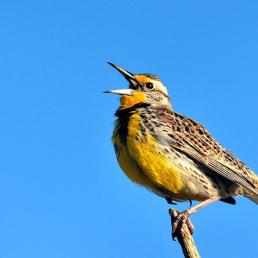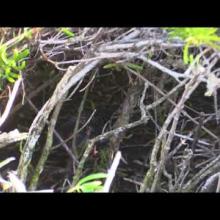

Join BirdNote tomorrow, November 30th!
Illustrator David Sibley and actor H. Jon Benjamin will face off in the bird illustration battle of the century during BirdNote's Year-end Celebration and Auction!
Black Rails are marsh-inhabiting birds, more often heard than seen. Many Black Rails nest in marshes along the Atlantic seaboard and in the Midwest. But in winter they concentrate in the coastal marshes of East Texas, Louisiana, and Florida, areas that face many threats. US populations of Black Rails have declined greatly. In recent decades, the enactment of laws protecting wetlands has improved the bird's prospects. Still, the Black Rail remains on American Bird Conservancy's "red list."
BirdNote®
Black Rails by Night
Written by Bob Sundstrom
This is BirdNote. [Black Rail calling, using the “kee-kee-doo” type calls]
As the February moon rises over a Louisiana marsh, a peculiar sound breaks the nocturnal silence. [Black Rail calling, the “kee-kee-doo” type calls] It’s the call of a Black Rail, a bird whose voice seems pulled straight from a cartoon soundtrack. [Black Rail calling, the “kee-kee-doo” type calls]
Black Rails are one of a half dozen North American rails, a group of marsh-inhabiting birds more often heard than seen. Just six inches tall, the Black Rail is a puffball, the shape of a barnyard chick. For birdwatchers, seeing a Black Rail is akin to seizing the Holy Grail: Black Rails are not only tiny and dark, but they are secretive and most active at night. [Black Rail calling, the “kee-kee-doo” type calls]
Many Black Rails nest in marshes along the Atlantic seaboard and in the Midwest. But in winter they concentrate in the coastal marshes of East Texas, Louisiana, and Florida; areas that face many threats. US populations of Black Rails have declined greatly.
In recent decades, the enactment of laws protecting wetlands has improved the bird’s prospects. Those who support the conservation of wetlands help assure that this shy bird’s comical voice will be heard for many years to come. [Black Rail calling, the “kee-kee-doo” type calls]
For BirdNote, I’m Mary McCann. Today’s show brought to you by The Lufkin Family Foundation.
###
Bird sounds provided by The Macaulay Library of Natural Sounds at the Cornell Lab of Ornithology, Ithaca, New York. Call of a Black Rail recorded by G.A. Keller; T. Wiewandt; crickets by N. Tucker.
Producer: John Kessler
Executive Producer: Chris Peterson
© 2015 Tune In to Nature.org February 2015 / 2022 Narrator: Mary McCann
ID# SotB-BLRA-01-2011-02-09
References include: Birds of North America Online and The American Bird Conservancy Guide to Bird Conservation.




